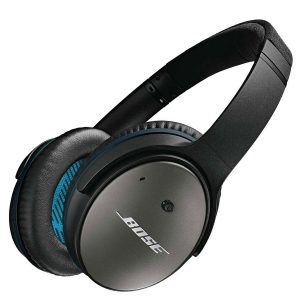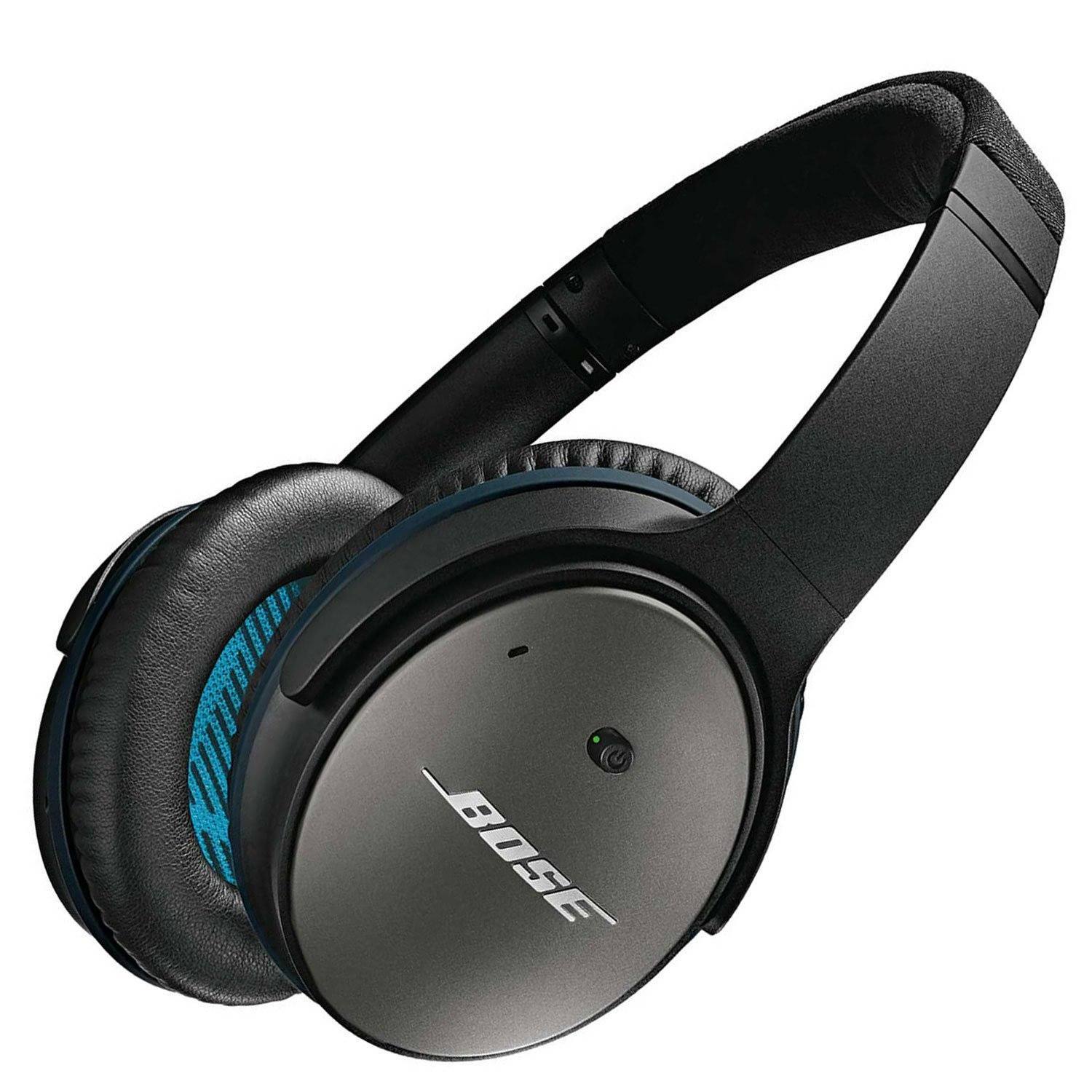In this review of the Bose Quiet Comfort 25, I’ll not only be covering the features, comfort and sound quality but also compare these to the Bose QC15 and ultimately help you decide is these are the headphones for you or not.
So I’ll start out by showing you the accessories and then give you a closer look at the design and features.
Included Accessories (ie. case, cables, manual, etc.)
Included with the headphones are a manual, cable with in-line remote, airline adapter, 1 AAA battery and a hard travel case.
The headphone cable is 56” long, it terminates in a 3.5mm plug and attaches to the left ear cup. The in-line remote is fully functional with Apple products, but just the play and pause buttons will work for Android, Blackberry and Windows phones.
The included hard-sided case looks nice and does a great job protecting the headphones. Its back side includes a stretchable sleeve which functions as an extra compartment for accessories or small items. This case is also about 30% smaller than the case for the previous model, the QC15, which makes it that much better for travel and portable use.
 Design, Features & Build Quality
Design, Features & Build Quality
When it comes to the design, features and build quality, the QC25 is well thought out and makes incremental improvements over the QC15 on almost every front. For example, smart enhancements were added to this headphone like the rubber guard around the ear cups. This not only improves the comfort but it’s also functional by protecting the finish of these headphones when laying them down on a table or storing them in their case as the ear cups won’t scratch against each other when being folded up.
Also, The QC25 allows you to use them passively, even after the battery runs out. Battery life is approximately 30-35 hours depending on how loud you like to listen to your music.
The QC25’s minimized yet contemporary design has less flash than its predecessor with a choice between either a gray and black look, or the tan and white combination. You also have the option of personalizing your headphones through Colorwave, which is available through Bose’ website for an extra $100.
In terms of build quality, these do have a plastic feel to them just as the QC15 did, but they’re still well built and durable. You can stretch the headphones horizontally or bend them sideways without causing any damage.
Regarding comfort, the QC25 is one of the most comfortable headphones in existence. They are incredibly light for an over-ear headphone, weighing in at just 6.9 oz without the cable.
The headband is padded with a bit of cushion inside for extra comfort. And like the QC15, you can also adjust the size of the headphones using a click adjustment. There’s plenty of room here even if you have a large head. Also, you don’t have to really worry about these slipping off your head because they give you a secure fit without being clampy at all.
The ear cups have plenty of room even if you have larger ears and they also swivel 90 degrees for easier storage.
The ear pads are plush feeling and you can comfortably wear these all day without any discomfort around your ears, head or jaw. These are truly perfect for long listening sessions whether traveling, at work or just using them at home.
Active Noise Cancellation
Next I’ll talk about how these worked as noise cancelling headphones. But first I want to make sure that the difference between noise cancellation and noise isolation is understood. Noise isolation is when the external sound is suppressed by your headphones, whereas Active Noise Cancellation is achieved by having inverse waves passing through the headphone speakers, which is what helps to cancel out the surrounding noise. So this works best with lower frequency sounds such as the drone of an airplane engine, subway noise, or the whirl of an office air conditioner.
Now just like with the QC15, If you haven’t used effective noise cancelling headphones before, you’ll be blown away by how powerful this feature can be. When it comes to active noise cancellation, Bose is simply the best and the QC25 truly decimates all low-end noise. Airplane engines and similar type noises disappear on these making them perfect for use on airplanes, trains, busses and the subway. Even just walking next to a road, it’s impressive how much these dampen the noise of passing cars.
Now as I alluded to earlier, these aren’t as effective at cancelling out higher frequency noise. So if you’re using these in an office, you’ll still be able to hear people’s voices, especially female ones but these do help take the edge off of nearby conversations.
In order to use the active noise cancellation feature, you’ll need 1 AAA battery. Now if your battery runs out, you won’t be able to use the ANC, but you will be able to use your headphones passively, which is an improvement over the previous model, the QC15. Also, you have the option of turning the ANC on or off so you’re never forced to use it. The downside though is that when the ANC is not in use the sound quality suffers which I’ll talk more about soon.
Overall, in terms of noise cancellation, no other over-ear headphones do a better job than the QC25. Even compared to the QC15, these have slightly better noise cancellation when it comes to the low frequencies. These headphones are fantastic and are truly designed to be used in noisier environments. And whether you’re on an airplane or riding the subway, you’ll still be able to have a very quiet and intimate listening experience.
Sound Quality
Next, I’ll talk about the sound quality which is really good, and these do have a very enjoyable sound signature. Overall, these are a warm, smooth and relaxed sounding headphone with a good overall balance and neutrality to them. They’re relatively clean sounding and provide clear details with instruments and vocals.
The bass is emphasized a bit but still well managed. It has a tight, punchy quality to it without sacrificing clarity in the mids and highs. Bass extension is also very good, though sub-bass is lacking just slightly. But overall, lower frequencies have a really nice deep, rich and full sound to them. And whether you’re listening to more contemporary genres or classical pieces, the bass is very satisfying to listen to.
The midrange is wonderfully neutral, smooth and coherent. Vocals and guitars are lifelike and natural and there’s good instrument separation. There is a bit of a spike in the upper mids, but the overall presentation is smooth and still quite pleasing to the ears.
The highs are nicely detailed with no distortion at higher volumes. However, the mid-treble response is a just tad artificial sounding and slightly colored. Sometimes your ‘S’ sounds can come across a little more pronounced. But the QC25 never sounds harsh or strident in the least, and as a result, you can listen to these for hours without fatigue. Overall, there’s plenty of life and energy in the treble region to make these a very engaging headphone to listen to.
Now as I alluded to earlier, the sound quality is affected when using these in passive mode, in other words, when the ANC is turned off.
The lows become a bit muddy and there’s less deep bass. There’s a little less clarity in the mids and the treble response is also decreased by a couple of decibels. So while they don’t sound as good as with the ANC turned on, they don’t sound bad either. And obviously, it’s better to have some sound than no sound at all if your battery runs out and you don’t have a replacement.
But the bottom line on sound quality is that these will sound great with any genre of music. You can listen to these for hours and hours without any fatigue and yet you’ll still get a performance that is very lifelike and engaging.
Comparison to other headphones
Now comparing these to the previous model, the Bose QC15. The improvements are more incremental as the QC15 was a solid headphone to begin with.
Regarding the design and features, the QC25 comes with a case that’s about 30% smaller which makes them even better suited to traveling or portable use. And then comparing the noise cancelling ability of the two, the QC25 is slightly better with lower frequencies and the overall sound isolation it provides is a few dB quieter.
In terms of sound quality, the overall sound of the QC25 is much tighter and more refined. The QC25 also has a stronger peak in the low bass. So as an example, notes played from a kick drum or a bass guitar come through with more dynamics and punch.
So overall, whether you’re talking about features, comfort, or sound quality the QC25 is definitely the better choice.
And then comparing these to the Bose QC20, the QC25 does a slightly better job overall with noise cancellation.
In terms of sound quality, the QC20 provides a more mellow sound signature by comparison as you get less of an upper-midrange spike and less bass. So between the two, the QC25 provides a more engaging listening experience.
Finally, comparing these to the PSB M4U 2, the PSB is a slightly better sounding headphone, but they just can’t compete against Bose for noise cancellation. In this department, the QC25 is the clear winner.
Reasons to consider something else
So at this point, it may sound like the QC25 are the noise cancelling headphones to get, but there are a few things to consider just to be sure.
For example, if you’re looking for something to block out conversation type noise or more higher frequency noise, then you may prefer a pair of headphones that have better noise isolation such as IEM’s or other closed-back, over-ears headphones such as the M50X. Part of what you’re paying for with the QC25 is the noise cancellation feature. And while that can offer some huge benefits, especially for travelers, if you’re not able to take advantage of that, then they may not be worth the additional cost.
And then if sound quality is first and foremost and noise cancellation is second, then you may prefer the PSB M4U 2. For instance, maybe you’d like to have noise cancellation as a feature, but it’s not something you’ll use that often and it’s certainly not the primary reason you’re buying them, that’s where the PSB could be a better choice.
BOTTOMLINE
But otherwise, if you want the best pair of over-ear noise cancelling headphones available, the Bose QC25 is the clear winner. They’re one of the most comfortable, light-wearing headphones on the planet, they’re very portable and great for traveling, and the sound quality is very good. Sure there are other non-noise-cancelling headphones that sound a bit better for the money.
But the differences are small enough that most people aren’t going to notice that much, if at all. Also, the ability to use these passively is a huge plus over the previous QC15 and many other noise cancelling headphones currently in the market that still don’t offer that as a feature.

